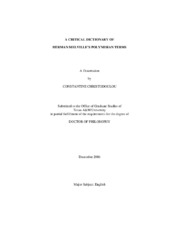| dc.description.abstract | The dissertation is divided into five chapters and focuses primarily on Melville’s
Typee, Omoo, Mardi, and Moby Dick.
Chapter I introduces the idea that Melville understood Polynesian better than
what critics have demonstrated, and that he used the Polynesian language to develop his
own multicultural aesthetic.
Chapter II discusses how Melville attempts to resolve his aesthetic
preoccupations by opening his narratives to the literary potential of the Polynesian
language. The chapter examines representative examples of the orthographic
idiosyncrasies of Melville’s Polynesian adoptions and adaptations which describe his
new literary aesthetic. The chapter also investigates how Melville’s Polynesian aesthetic
affects the construction of meaning in his texts. The chapter finally discusses examples
of past editorial choices which have sidestepped Melville’s Polynesian aesthetic and,
thus, provided readers with a limited understanding of the Polynesian language’s role in
Melville’s texts. Chapter III analyzes samples of Melville’s Polynesian adoptions and adaptations
from the above narratives to emphasize the role of the Polynesian language in his Pacific
experience. This chapter’s intention is to underline the interaction between Melville’s
Polynesian language and culture and his texts, which engendered a complex
multicultural aesthetic that permeated his first three works, continued to influence his
later writings, and contributed significantly to his cosmopolitan vision of American
cultural identity.
Chapter IV contains the dictionary, which incorporates approximately two
hundred entries. Each entry is divided into four sections. The first is a series of quotes
from Melville’s texts that illustrate the various meanings that Melville has given to the
term being examined. The second is a list of definitions from various dialects, intended
to underline the various Polynesian linguistic elements that Melville adopted or adapted
to construct each particular term. The third is an interpretative paragraph that explains
how each term is divided into its constituent parts based on Melville’s aesthetic. The
fourth section contains specific quotes from other sources of the particular term that
underline the significance of that source to Melville’s knowledge of the particular term.
Chapter V concludes with the idea that this dissertation is meant as a starting
guide to reexamining Melville’s Polynesian aesthetic. | en |


